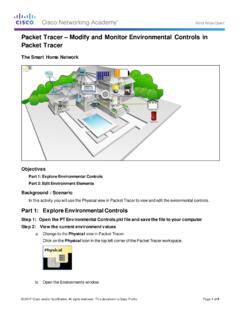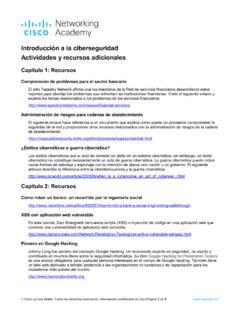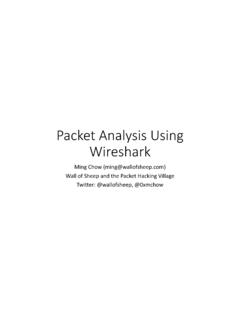Transcription of Packet Tracer Explore Network Functionality Using PDUs
1 2017 Cisco and/or its affiliates. All rights reserved. This document is Cisco Public. Page 1 of 6 Packet Tracer Explore Network Functionality Using PDUs Topology Addressing Table Device Interface IP Address Subnet Mask Default Gateway PC Ethernet0 DHCP Wireless Router LAN Internet DHCP Server Ethernet0 Laptop Wireless0 DHCP Objectives Part 1: Create a Simple PDU in Simulation Mode Part 2: View Contents of PDUs Part 3: Create a Complex PDU in Simulation Mode Background / Scenario In this activity, you will open the saved Packet Tracer activity that was completed in Chapter 2, and use the Simulation mode to create PDUs to Explore Network Functionality . Packet Tracer Explore Network Functionality Using PDUs 2017 Cisco and/or its affiliates.
2 All rights reserved. This document is Cisco Public. Page 2 of 6 Part 1: Create a Simple PDU in Simulation Mode Ste p 1: Ope n the .pka activity a. Navigate to the .pka activity that was completed in Chapter 2. Navigate to the directory that contains the Packet Tracer Activity that was completed in Chapter 2. Open the activity and click the Simulation mode icon in the bottom-right corner of the Packet Tracer window to open the Simulation panel. Ste p 2: Cre ate a simple PDU. a. Create a simple PDU that sends a ping from the PC to the laptop Click the Add Simple PDU icon (looks like a closed envelope) in the right pane of the Packet Tracer window. The curser will change to an envelope with a plus sign. Click the PC first so it will become the source of the ping and then click the Laptop so that it will become the destination.
3 Packet Tracer Explore Network Functionality Using PDUs 2017 Cisco and/or its affiliates. All rights reserved. This document is Cisco Public. Page 3 of 6 Expand the Event Simulation pane by clicking the gray arrow at the bottom right of the Packet Tracer Window. b. Observe traffic moving through the Network . Click the Capture/Forward button and observe the traffic move through the Network each time the button is clicked. Notice also that each time the Capture/Forward button is clicked, sent packets are displayed in the Event List window. Continue clicking the Capture/Forward button until the return ICMP Packet makes it back to the PC. Packet Tracer Explore Network Functionality Using PDUs 2017 Cisco and/or its affiliates.
4 All rights reserved. This document is Cisco Public. Page 4 of 6 Part 2: View Contents of PDUs Ste p 1: Use e vent list to see PDU information a. View the information of the first ICMP PDU Packet from the PC. In the Event List window, click the green square under the Info column for the first ICMP PDU at the top of the list. This will open the PDU Information at Device: PC window. Observe the information in the OSI Model tab. Notice that this is an outbound Layer 3 PDU and the source and destination IPv4 address is shown. Packet Tracer Explore Network Functionality Using PDUs 2017 Cisco and/or its affiliates. All rights reserved. This document is Cisco Public. Page 5 of 6 Next, click the Outbound PDU Details tab.
5 Notice that this tab shows details of the protocol headers. b. Explore the contents of other PDUs listed in the Simulation Panel and review the information that is available in each. Packet Tracer Explore Network Functionality Using PDUs 2017 Cisco and/or its affiliates. All rights reserved. This document is Cisco Public. Page 6 of 6 Ste p 2: De le te the simple PDU c. Delete the simple PDU Using the Event Simulation pane. Click the Delete button in the Event Simulation pane at the bottom of the Packet Tracer window. Notice that this removes the simple PDU and clears out all PDUs from the Simulation Panel Event List. Part 3: Create a Complex PDU in Simulation Mode Ste p 1: Cre ate a complex PDU a. Add a complex PDU to send pings from the PC to the laptop.
6 Click the Add Complex PDU icon, the one that looks like an open envelope, in the right pane of the Packet Tracer window. The curser will change to an envelope with a plus sign. Click the PC first so it will be the source device of the pings and then click the Laptop so that it will be the destination. The Create Complex PDU window will display. b. Configure complex PDU settings to send the pings every 5 seconds. In the Create Complex PDU window, there are many settings which can be customized. To send a ping every 5 seconds from the PC to the laptop, the Destination IP Address field must have the IPv4 address of the laptop, The Source IP Address field should be the IP address of the PC, At the bottom in the Simulation Settings section click Periodic and set the Interval to 5 seconds.
7 C. Observe traffic moving through the Network . Click the Auto Capture / Play button and watch the traffic move through the Network and notice the PDUs populating the Simulation Panel Event List. Because we set the complex PDU to an Interval of 5 seconds, a new PDU will be created every 5 seconds. Click the Auto Capture / Play button again to stop the simulation. To delete the complex PDU, click the Delete button in the Event Simulation pane at the bottom of the Packet Tracer window.











